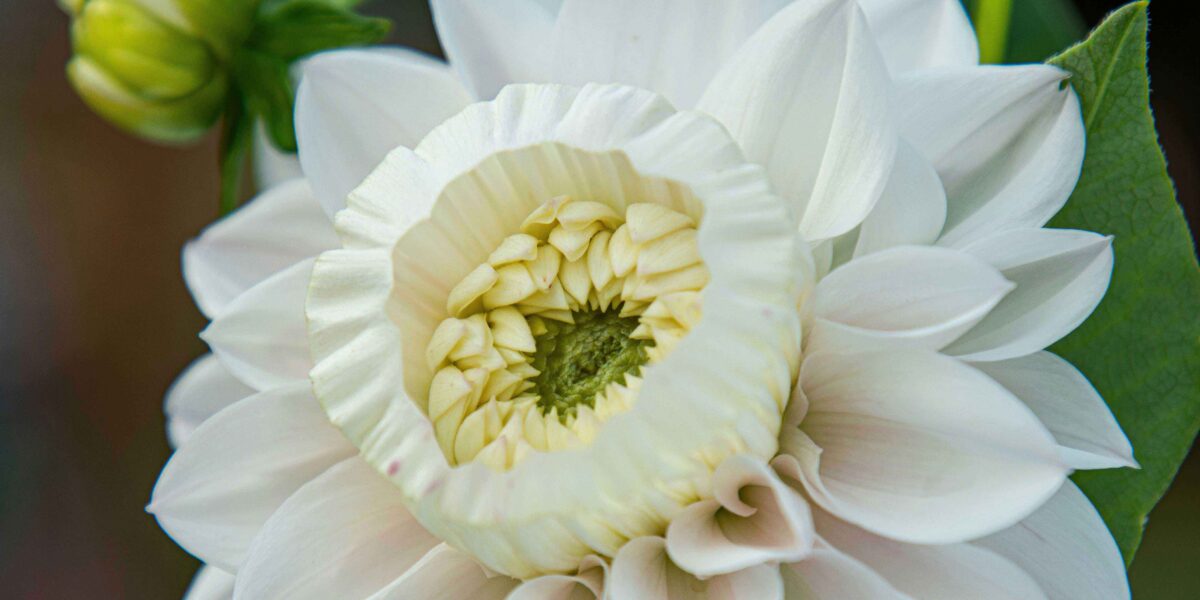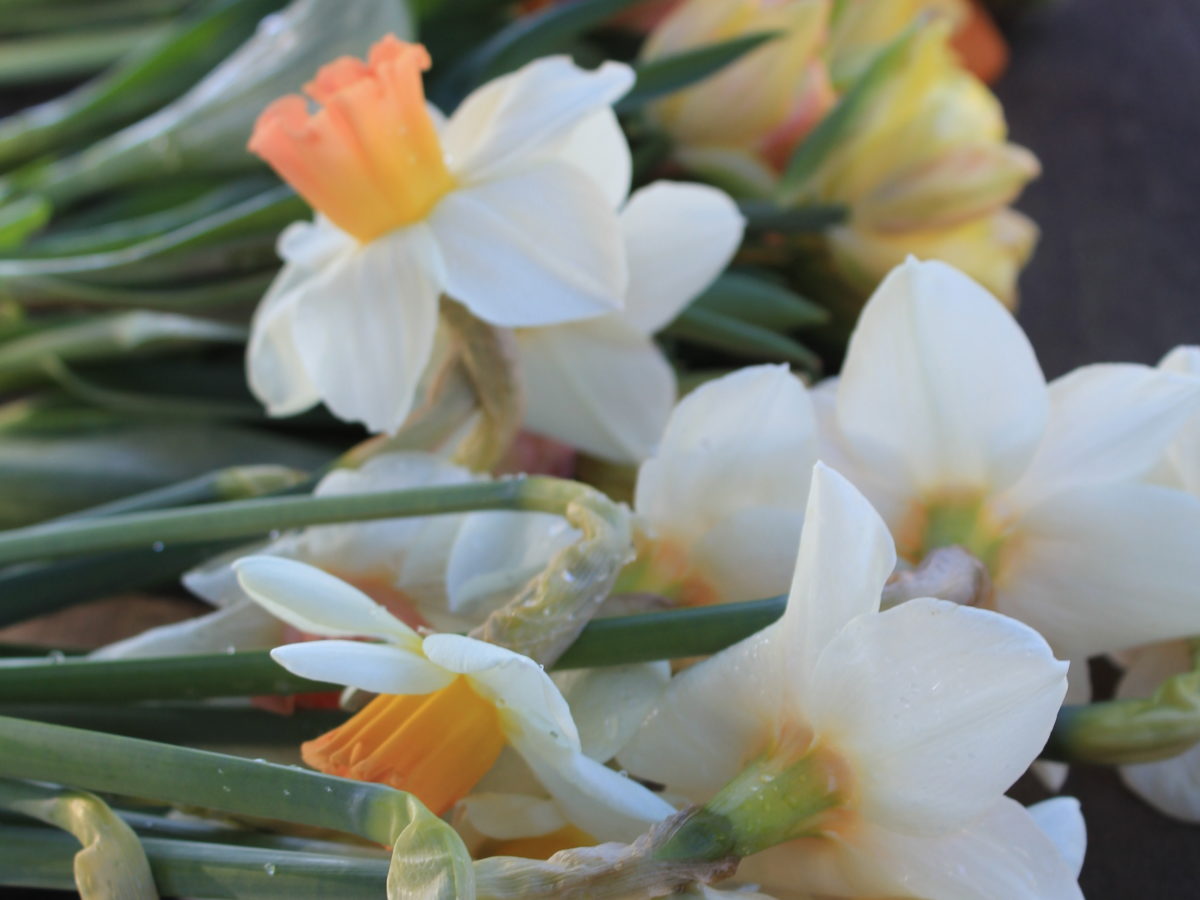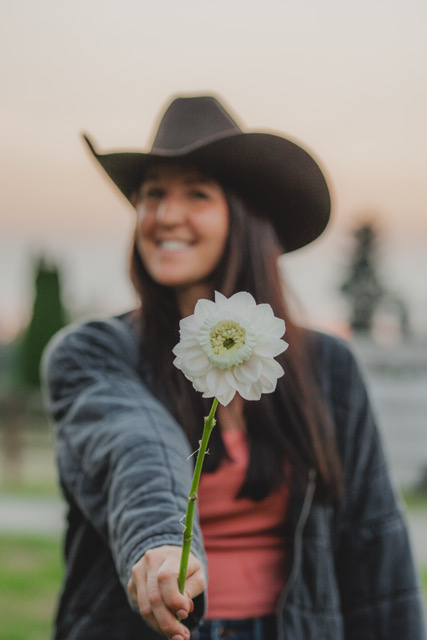
The Internet Is Losing Its Mind Over This New ‘It’ Flower
Everything you need to know about the viral “Daffodahlia,” which looks like it’s part-daffodil, part-dahlia, and all a little mind-blowing.

Perhaps you, like many garden enthusiasts, had your social media feeds flooded with a flower so cutesy, many argued it was an AI-generated image. This dahlia, with a cup-like shape similar to a daffodil, has now been lovingly named the “Daffodahlia,” and it has hobby flower farmers and florists alike feverishly hoping this random mutation might turn into a new hybrid of dahlia.
According to Kelsey Hall, flower farmer and owner of the family run business Cattle & Cut Flowers in Enumclaw, Washington, the variety of dahlia this hybrid appeared from is one that they have grown for years. This was the first season that six of 35 plants started creating varying degrees of the daffodil shape in late August. Hall explains that, “It was not every bloom on the plants but more than half the blooms were making that shape. The plants maintained the correct color of the variety and it was just the petals forming rings forward rather than rolling back.” Hall, also a wedding florist, noted there are other plants growing in the same area, including other dahlias, cosmos, zinnias, and phlox. She adds, though, that there was never a belief that the other flowers were causing this; rather it could be some environmental issue causing the change. Hall says she has suspicions as to what may have happened, but will not be able to confirm without another season.
Mutation or Possible New Breed
Although there are many varieties, dahlias typically look like the flowers above…
As anyone who’s ever grown backyard flowers knows, mutations happen, and are most often not stable enough for breeding due to cross pollination and other environmental factors. Hall agrees and cautions that there’s some doubt the Daffodahlias will return. She says she is saving seeds from the blooms that mutated, in addition to pulling leaf and sprout cuttings to nurture in her grow room, and saving the tubers to grow out next season and trial the environmental changes she thinks may have caused it.
Virus or Non-Threat Hybrid
Hall informed us the plants have been tested for the common dahlia issues, and she will monitor for clues when the tuber clumps are pulled up. She was advised that bioinformatics whole-genome sequencing could be done if breeding becomes a more serious option, but added it is very costly and that researchers are still trying to figure out how to interpret the type of information these tests provide. In future growing seasons, and if the Daffodahlia form returns, there will be a more intensive testing process before stock would be offered to the public.
What the American Dahlia Society Thinks
Upon reaching out to the American Dahlia Society, we found that Public Relations Coordinator Larry Smith wasn’t initially wowed with the viral specimen, stating, “if the photo is actually a legitimate new type, I wasn’t impressed with the form, including the hard green center and personally would not be interested in growing it. Others, who have an interest in something ‘different,’ will likely see it differently.”

When it comes to stock testing and mutations, we inquired if there are any concerns with the sudden spotlight on this particular bloom and Smith offered that, “Time will tell if it is something that will catch on or is a flash in the pan.”
What Expert Garden Designers Think
When it comes to viral plants, the floodgates are wide open with heated opinions. Chia-Ming Ro of Coastal Homestead, a professional garden educator and designer who’s no stranger to navigating and creating content on the internet, opines that, “On one hand, it’s wonderful when you get people excited about a new plant or variety and share their love for plants, driving demand and growth for small businesses. On the other hand, misinformation can spread like wildfire. In this case, non-growers can say the wrong thing, or not have all the information, or even omit details and inadvertently spread misinformation to the general population about a new breed of flower cross when it’s simply a mutated dahlia that may be a one-time anomaly.”
All internet hubbub aside, it comes down to dahlias still being in their “wild west” era. Chia-Ming adds, “I see a lack of intellectual property protection for new varieties produced by reputable breeders and even localized standards for who can be a grower/producer. I believe the next 5-10 years will bring about a lot of changes in rules and regulations around dahlia production.”
As we see it? Everyone’s allowed some excitement, but don’t get your hopes up that this will be a widespread gardening or floristry offering in the near future.
What Floral Pros Think
When it comes to the flower arts community, there is nothing but overwhelming cheer for the “Daffodahlia.” Washington-based author, floral design instructor, and artist Kristen Griffith VanderYacht posted a reaction video in response to the flower’s online debut and told us, “I don’t know if the flower is going to change the industry, but I do think that it is an exciting moment for florists and farmers and flower lovers everywhere to be reminded of the miraculous and wonderful things that can happen in nature. I think it’s a beautiful time to reflect and reinvigorate the industry that continues to evolve and grow just like this unique bloom.”
The “Daffodahlia” looks like cross between a daffodil and a dahlia, even though this is not actually what happened.
When it comes to social media, VanderYacht agrees it is wonderful for connection, but also admits to not loving how unpredictable it is. When it comes to things that go viral, you should always be wary, but also do your own research to validate information before sharing. In this case, VanderYacht reached out to Cattle & Cut Flowers to express excitement and began a conversation before sharing their story. Assuring that, “When we are able to use social media to put a spotlight on dedicated professionals in this industry, it can be helpful. Does that mean that the work is done when the content comes out? No it doesn’t. It just means that this meteoric moment is being honored, and that the work will continue.”
When asked how someone might style this flower, VanderYacht suggests, “When you have blooms that have an interesting texture like this, less is always more. As I would with something like a lotus pod or a traditional Dahlia, I think positioning them in an arrangement or bouquet so it feels like they are front and center and giving them space to breathe so they’re not crowded on top of one another is a great way of showcasing their beauty without overwhelming the senses.”
The Future of the “Daffodahlia”
Cattle & Cut Flowers has been approached by bulb companies, growers, farms, and lawyers all eager to involve themselves in this discovery process. At this time, Kelsey Hall reports that they are keeping everything in-house within trusted dahlia growing friends they have known for years with a goal to insure they are protecting themselves as they explore breeding options, if any.

Photo courtesy of Kelsey Hall/Enumclaw Dahlia Farm
If this mutation were to become a stable hybrid, Hall agreed the “Daffodahlia” would give spring daffodil forms a chance to be part of design work in the late summer and fall, much like waterlily form dahlias give a peony look when peonies are out of their season. While she hasn’t had the chance to work with any cuttings in an arrangement, as she is allowing choice specimens to go to seed rather than harvesting, she did suggest they would be an excellent stem for any style of airy spring-inspired arrangement.
Before this particular flower took over social media, Hall did not have a lot of interest in hybridizing dahlias, but now with a new open mind she will be expanding the dahlia field to include more hybridizing and studying her theories surrounding the Daffodahlia. Moving forward, the farm’s focus will be leaning more heavily into dahlias as Hall plans to take on less wedding arrangement work during late summer and fall to allow for a more dedicated seed-saving process.
“I feel really excited about this opportunity for our farm! It is potentially life-changing for us,” Hall says optimistically. But with any overnight fame there is caution, especially with concerns about many people coming out of the woodwork including varying opinions on how the flower should be handled, and even recent trespassing on their family’s private property by unauthorized associations.
Perhaps the “Daffodahlia” is a gentle reminder that there are very nice and normal people behind every 15 seconds of internet fame, and we should all be patient as they find their footing navigating the next chapter. While we hope a flower so sweet could become the real deal, we also can appreciate nature and all its uniqueness—and for that we celebrate it regardless.
Here’s to unusual and beautiful discoveries growing in your garden too!
